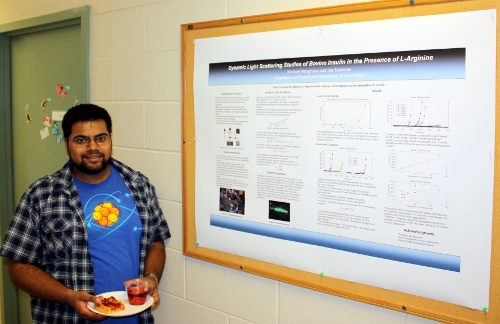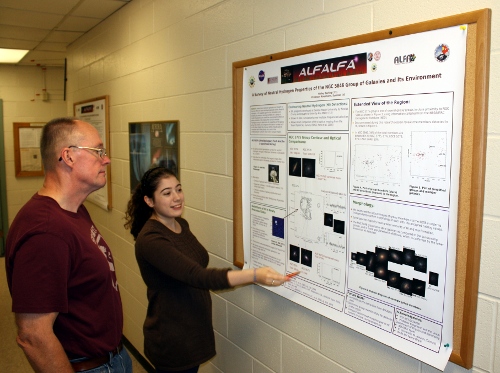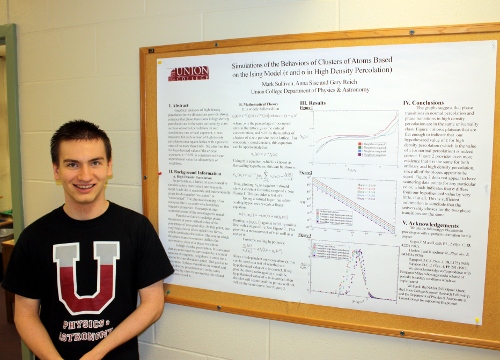
Michael Varughese ’11 worked with Prof. Jay Newman this summer, using dynamic light scattering to study the way that insulin molecules clump together over time. In addition to providing information about insulin itself, the processes by which insulin molecules aggregate are similar to those of β-amyloid, which has been implicated in Alzheimer’s disease.
Michael’s Poster (673 kB GIF)
Speaker:Dr. William Ostendorff, Nuclear Regulatory Commission
Title: Principles of Physics for Nuclear Power
As always, the colloquium will be at 12:40 in Room N304, with pizza and soda available at 12:20 for those attending the talk. For details of future colloquia, see the Fall 2010 colloquium schedule.

Halley Darling ’13, shown explaining her summer research poster to Prof. Mike Vineyard, worked with Professor Koopmann using the Arecibo telescope to study hydrogen gas in a nearby group of galaxies. Their observations will help astronomers understand the evolution of galaxies and star formation within galaxies.
Halley’s Poster (6.9 MB PDF)

Mark Sullivan ’13 worked with Anna Sise ’12 (who is on term abroad this Fall) and Prof. Reich doing computer simulations of atoms in lattices. The systems they studied are related to the physics of phase transitions in magnetic materials.
Mark’s poster (519 KB .gif)
Speaker: Prof. John Cummings, Siena College
Title: Neutrino Physics and The Dayabay Experiment
Abstract: There has been a resurgence in interest in neutrino physics in the last 10 years. The observations of the Super-Kamiokande Experiment in 1998 indicated the “oscillation” of one flavor neutrino into another. Several experiments, now running or soon to begin, are attempting to map out the details of the neutrino mixing responsible for this oscillation phenomena. I will present a (brief) history of our understanding of the neutrino, and describe the phenomena of neutrino oscillations and what we can learn from them. Finally, I’ll describe the Dayabay experiment and it’s goals.
As always, the colloquium will be at 12:40 in Room N304, with pizza and soda available at 12:20 for those attending the talk. For details of future colloquia, see the Fall 2010 colloquium schedule.
Speaker: Prof. Charles Freeman, SUNY Geneseo
Title: The Physics of Baseball
Abstract: Baseball is a particularly interesting game for a physicist to study. What makes a curve ball curve? How much farther does the ball really travel at Coors Field in Denver than at Citi Field in New York? Why do left handed pitchers have more success against left handed batters (and right handed pitchers have more success against right handed batters)? What is the difference between a two-seam and a four-seam fastball? How do you throw a split-fingered fastball, anyway? An ex-pitcher and current physicist sheds some light on these questions and discusses some other interesting physics at work in our national pastime. Feel free to bring your glove — you just might catch a souvenir.
As always, the colloquium will be at 12:40 in Room N304, with pizza and soda available at 12:20 for those attending the talk. For details of future colloquia, see the Fall 2010 colloquium schedule.
News and Events in Union College Physics and Astronomy


